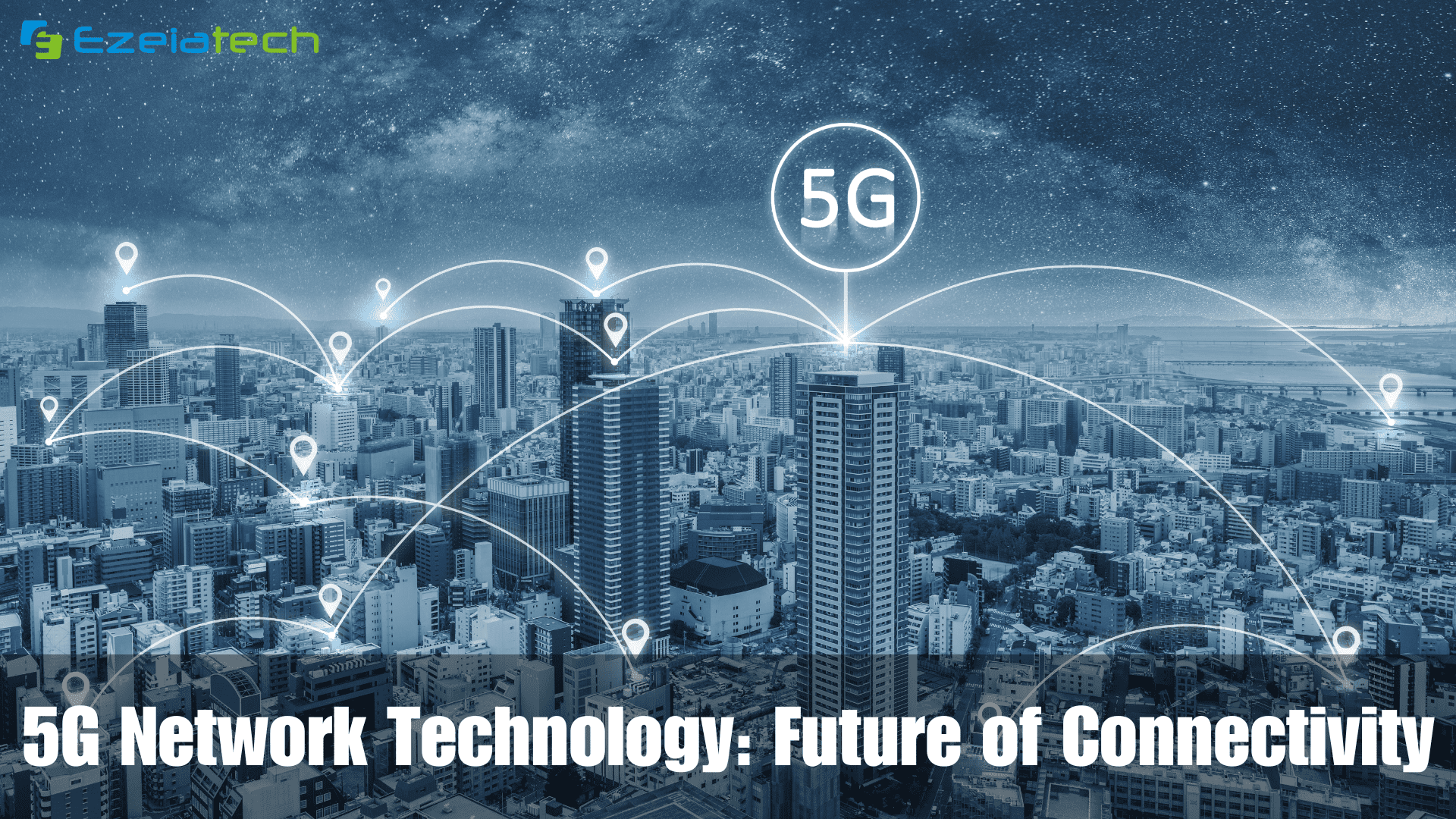Did you know that by 2025, there will be an estimated 4.1 billion 5G connections worldwide? That’s more than half of the global population! 5G Network Technology is revolutionizing communication and connectivity, promising faster speeds and greater reliability.
5G network technology is set to revolutionize connectivity as we know it. With its lightning-fast speeds, low latency, and ability to connect billions of devices simultaneously, 5G has the potential to transform industries, reshape societies, and unlock unprecedented opportunities for innovation.
Key Takeaways:
- 5G network technology is expected to have a global reach of 4.1 billion connections by 2025.
- 5G offers faster speeds, lower latency, and the capacity to support massive device connectivity.
- Industries such as autonomous vehicles, smart cities, and healthcare can greatly benefit from 5G.
- Building a robust 5G network infrastructure is crucial for widespread adoption.
- Addressing security challenges is vital to ensure user privacy and data protection.
Understanding 5G Network Technology
As technology continues to advance at a rapid pace, 5G wireless networks are set to redefine the way we connect to the internet. With its lightning-fast speeds and enhanced capabilities, 5G technology offers a host of benefits that are poised to revolutionize our digital experiences.
At its core, 5G network technology is designed to provide faster and more reliable internet connectivity. By employing higher frequency bands and advanced wireless technology, 5G networks can transmit data at speeds that are significantly faster than their predecessors.
One of the key advantages of 5G technology is its ability to handle a massive amount of data traffic without compromising performance. This means that even in densely populated areas, where network congestion has traditionally been a challenge, users can enjoy seamless connectivity and uninterrupted internet access.
Moreover, 5G wireless networks offer significantly lower latency, which refers to the time it takes for data to travel between devices and the network. This reduction in latency has a profound impact on various applications, such as online gaming, video streaming, and real-time interactions. With 5G, users can experience minimal delays and instant responsiveness, enhancing their overall digital experience.
But the benefits of 5G technology extend beyond just speed and low latency. Its increased network capacity and scalability enable the seamless integration of innovative technologies like Internet of Things (IoT), autonomous vehicles, and smart cities. These applications rely on a robust network infrastructure, and 5G technology provides the foundation for the interconnectedness of devices that can transform the way we live and work.
5G technology offers faster and more reliable internet connectivity, lower latency, and increased network capacity, paving the way for a truly connected future.
With the deployment of 5G networks, industries such as telecommunication, healthcare, transportation, and entertainment stand to benefit from increased efficiency, productivity, and innovation. For instance, in healthcare, 5G technology can support the development of advanced telemedicine solutions, enabling remote patient monitoring and faster access to critical medical services.
Overall, 5G network technology holds immense potential to transform our digital landscape. By providing faster speeds, low latency, and increased network capacity, 5G will revolutionize the way we connect, communicate, and conduct business in the future.
Building the Infrastructure for 5G Networks
As 5G network technology continues to revolutionize global connectivity, the importance of building a robust infrastructure cannot be overstated. The success of 5G networks depends on two critical factors: network speed and coverage. In this section, we will delve into the essential components required to establish a reliable 5G network infrastructure that can support high-speed connections and provide extensive coverage.
The Need for High-Speed Connections
At the heart of 5G network technology lies the need for lightning-fast speeds to support the increasing demands of data-intensive applications. With the proliferation of smart devices and the advent of new technologies like augmented reality and autonomous vehicles, the demand for high-speed connections has never been greater. To meet these requirements, 5G networks rely on advanced technologies, including massive multiple-input multiple-output (MIMO), millimeter-wave spectrum, and small cells.
Expanding Coverage Areas
Another critical aspect of 5G network infrastructure is the expansion of coverage areas. Unlike previous generations of wireless networks, 5G aims to provide ubiquitous connectivity, extending beyond urban centers and into suburban and rural areas. Achieving this level of coverage requires a comprehensive network of base stations and antennas strategically deployed across geographical regions. With an extensive coverage area, 5G networks can deliver faster speeds and a seamless user experience to individuals and businesses alike.
“5G network infrastructure plays a crucial role in supporting the high-speed connections and extensive coverage needed to realize the full potential of 5G technology.”
| Components of 5G Network Infrastructure | Description |
|---|---|
| Base Stations | These are the backbone of 5G networks, serving as communication hubs that transmit and receive data. Equipped with advanced antenna technologies, base stations ensure optimal signal strength and coverage. |
| Fiber Optic Cables | As the backbone of high-speed internet connections, fiber optic cables are critical for supporting the bandwidth requirements of 5G networks. These cables provide the necessary data transmission speeds to meet the demands of data-intensive applications. |
| MIMO Technology | Massive multiple-input multiple-output (MIMO) technology allows for the simultaneous transmission and reception of multiple data streams, significantly increasing network capacity and enhancing data speeds. |
| Small Cells | Small cells are compact wireless access points that are strategically deployed in areas with high user density. By offloading traffic from macro cells, small cells improve network capacity and ensure consistent coverage, especially in crowded urban environments. |
Building a robust 5G network infrastructure entails careful planning, investment, and collaboration among telecom operators, government bodies, and technology providers. By prioritizing high-speed connections and extensive coverage, the foundation for a truly transformative 5G network can be laid, unlocking unprecedented opportunities for industries, individuals, and society at large.
Securing 5G Networks: Challenges and Solutions
As 5G networks continue to revolutionize global connectivity, it is crucial to address the unique security challenges that arise with this cutting-edge technology. With faster speeds, increased data capacity, and widespread connectivity, 5G networks require robust security measures to protect users’ safety and privacy.
The rapid advancement of 5G technology brings new vulnerabilities that hackers and cybercriminals can exploit. The increased number of connected devices and the sheer volume of data transmitted make 5G networks an enticing target for malicious actors. Moreover, the potential integration of critical infrastructure, such as autonomous vehicles and smart cities, further raises concerns about the consequences of cyber-attacks.
To ensure the security of 5G networks, the industry is actively developing innovative solutions. These solutions include:
- Virtualization: Leveraging virtualized network infrastructure to isolate and contain potential security breaches, preventing unauthorized access to sensitive data.
- Encryption: Implementing robust encryption methods to safeguard data transmitted over the network, protecting it from interception and unauthorized access.
- Authentication: Deploying strong authentication protocols to validate the identity of devices and users accessing the 5G network, ensuring only authorized entities can connect.
- Artificial Intelligence: Utilizing AI-powered security solutions to monitor network traffic, identify potential threats, and respond swiftly to mitigate risks.
- Cybersecurity Collaboration: Encouraging collaboration between telecom operators, device manufacturers, and cybersecurity experts to share information, best practices, and collectively address security vulnerabilities.
By implementing these and other innovative security measures, we can overcome the challenges posed by 5G network security and ensure a safe and secure digital environment for users. As the adoption of 5G technology continues to expand, it is essential for industry stakeholders to prioritize security to protect the privacy and integrity of our connected world.
Applications of 5G Network Technology
5G Network Technology opens up a vast array of possibilities for various industries and sectors. With its unprecedented speed, low latency, and high capacity, 5G offers groundbreaking applications that have the potential to transform the way we live and work. From autonomous vehicles to smart cities and advanced healthcare systems, let’s explore the diverse range of applications that can benefit from 5G Network Technology.
1. Autonomous Vehicles
One of the most promising applications of 5G Network Technology is in autonomous vehicles. With its ultra-fast speeds, 5G enables real-time communication and data transfer between vehicles, infrastructure, and pedestrians, ensuring safe and efficient transportation. This technology can revolutionize the automotive industry by enhancing navigation systems, enabling autonomous driving, and reducing accidents through better connectivity and communication.
2. Smart Cities
5G Network Technology plays a crucial role in the development of smart cities. By connecting various devices and sensors, 5G enables real-time data collection and analysis, leading to better urban planning, improved energy management, efficient transportation systems, and enhanced public safety. With 5G, cities can become more sustainable, interconnected, and responsive to the needs of their residents.
3. Advanced Healthcare Systems
5G presents numerous opportunities for advancing healthcare systems. With its reliable and high-speed connectivity, it enables seamless transmission of medical data, remote monitoring of patients, and telehealth services. This technology enhances the delivery of healthcare by facilitating telemedicine, remote surgeries, and real-time health monitoring, ensuring improved access to quality healthcare services for patients worldwide.
4. Industrial Automation
5G Network Technology revolutionizes industrial automation by enabling real-time communication and data transfer between machines, sensors, and control systems. With its ultra-low latency, 5G facilitates seamless coordination and synchronization of industrial processes, leading to enhanced productivity, efficiency, and safety. Industries such as manufacturing, logistics, and energy benefit from the transformative capabilities of 5G in optimizing operations and driving innovation.
5. Virtual Reality and Augmented Reality
With the high bandwidth and low-latency of 5G, virtual reality (VR) and augmented reality (AR) experiences are taken to the next level. Immersive gaming, interactive education, virtual shopping, and realistic simulations become more accessible and seamless with the power of 5G. This technology paves the way for new forms of entertainment, collaboration, and learning, unleashing the full potential of VR and AR applications.
| Application | Benefits |
|---|---|
| Autonomous Vehicles | – Enhanced navigation systems |
| – Improved road safety | |
| – Real-time communication between vehicles | |
| – Efficient transportation system | |
| Smart Cities | – Better urban planning |
| – Improved energy management | |
| – Enhanced public safety | |
| – Efficient transportation system | |
| Advanced Healthcare Systems | – Remote patient monitoring |
| – Telehealth services | |
| – Real-time health monitoring | |
| – Improved access to healthcare services | |
| Industrial Automation | – Real-time communication between machines |
| – Enhanced productivity and efficiency | |
| – Improved safety in industrial processes | |
| Virtual Reality and Augmented Reality | – Immersive and seamless experiences |
| – New possibilities for entertainment and learning |
Advantages and Implications of 5G Technology
As we delve deeper into the realm of 5G technology, it becomes evident that its advantages extend far beyond faster data rates and lower latency. The future of 5G technology promises to disrupt various industries and transform the way we live, work, and connect with the world around us.
Advantages of 5G Network
One of the primary advantages offered by 5G technology is its remarkably faster data speeds compared to its predecessors. With speeds reaching up to 10 gigabits per second (Gbps), downloading large files, streaming high-definition videos, and using bandwidth-intensive applications will become incredibly swift and seamless. This accelerated data transfer rate will revolutionize industries such as gaming, virtual reality, and video conferencing, where real-time responsiveness is crucial.
Another significant advantage is the reduced latency provided by the 5G network, boasting an ultra-low latency of fewer than 1 millisecond (ms). This near-instantaneous communication enables seamless interaction in futuristic applications like autonomous vehicles, remote surgery, and industrial automation. The ability to transmit information rapidly without delays will unlock new possibilities and empower industries to achieve unprecedented levels of efficiency and productivity.
Moreover, the increased capacity and improved network efficiency of 5G technology will enable a massive influx of connected devices. The Internet of Things (IoT) will flourish, connecting everything from smart homes and wearable devices to entire cities. This connectivity will create intelligent systems capable of gathering and analyzing vast amounts of data, resulting in enhanced efficiency, resource optimization, and improved quality of life for individuals and communities.
Implications for Various Industries
The implications of 5G technology extend beyond just faster speeds and connectivity. This groundbreaking innovation will have a profound impact on numerous industries and sectors.
In the healthcare industry, 5G will enable remote patient monitoring, telemedicine, and real-time health data analysis. This will revolutionize access to healthcare, especially in remote areas, and allow for more accurate diagnoses and personalized treatments.
Smart cities will leverage 5G technology to enhance efficiency, sustainability, and livability. From intelligent transportation systems and energy management to waste management and public safety, the seamless connectivity offered by 5G will redefine urban living, making cities more resilient and citizen-centric.
Industrial automation and manufacturing will witness significant advancements with 5G connectivity. The low latency and ultra-reliable communication will enable sophisticated robotics, precision control systems, and seamless coordination between machines. This will lead to increased productivity, improved safety, and more efficient processes in factories and industrial facilities.
These are just a few examples of the transformative impact of 5G technology across industries. As we continue to explore its capabilities and unlock its full potential, the future of connectivity will undoubtedly be shaped by the advancements and advantages offered by 5G networks.
| Advantages of 5G Network | Implications for Industries |
|---|---|
| Faster data speeds | Revolutionize gaming, virtual reality, video conferencing |
| Reduced latency | Enable autonomous vehicles, remote surgery, industrial automation |
| Increased device capacity | Empower Internet of Things (IoT) and smart city applications |
Conclusion
In conclusion, 5G Network Technology has emerged as a game-changer in the world of connectivity. With its lightning-fast speeds, enhanced network coverage, and numerous applications across various industries, 5G has the potential to revolutionize the way we communicate and interact with the world around us.
The benefits of 5G are vast and far-reaching. From enabling seamless streaming and immersive virtual reality experiences to empowering the Internet of Things and driving advancements in healthcare and transportation, the possibilities are endless.
However, as with any technological advancement, there are also challenges that need to be addressed, particularly in the realm of security. Protecting data and ensuring the privacy of users will be crucial to fully harnessing the potential of 5G.
As we move forward, it is clear that 5G Network Technology holds immense promise. With its transformative power, we can expect to witness an era of unparalleled connectivity, propelling us into a future where everything and everyone is seamlessly interconnected.
Thank you for reading. For continued insights and in-depth discussions, please follow our blogs at Ezeiatech.







